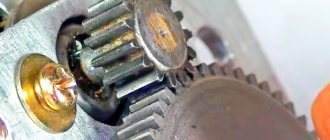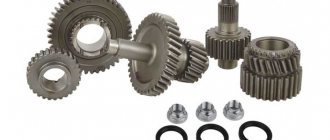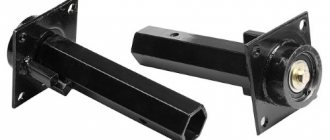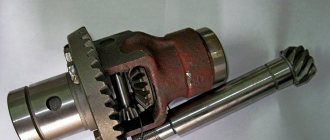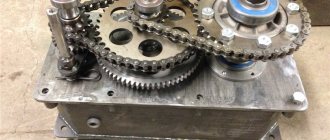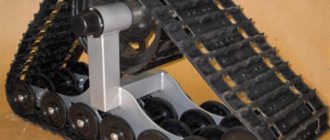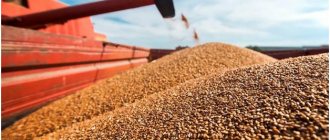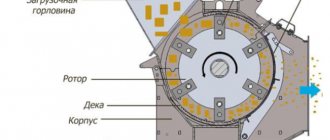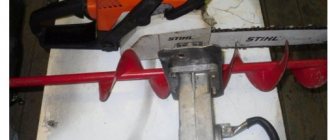Currently, many owners of home workshops equip them with modern tools and equipment, which, being highly efficient and easy to use, significantly facilitates work and increases its productivity. However, at the same time, quite technically simple devices that can be made with your own hands in a home workshop are still in demand. One of them is a reduction gearbox.
What is a reduction gearbox?
It is a special type of mechanism that serves as a transmission link between devices in which the active parts perform rotational motion. It is often used to transmit and convert torque from the unit that produces it to the device that uses the mechanical energy supplied to it. Unlike other types, a reduction gearbox provides a reduction in the number of revolutions and an increase in torque.
A reduction gearbox consists of a housing, gears, transmission chains, a worm mechanism, and shafts, with the help of which torque is transmitted and converted.
Toothed gears are located on the shafts in a rigid coupling, and worm gears are attached. They ensure the transfer of motion to each other, during which its transformation is carried out.
Manufacturing of the product body
Experts consider the body to be the most important part of the device. The frame must be properly designed and assembled, because the position of the axes and working shafts, the alignment of the holes for the bearings, and the distance between the gears and belt mechanisms depend on it.
In the factory, housings for reduction gearboxes are made by casting from cast iron or aluminum alloys. It is simply impossible to make such a blank on your own. For this reason, it is necessary to find or remodel the factory housing. It can also be welded from iron sheet.
Some home craftsmen were able to find a simple way out of the situation. In order not to engage in boring work, it is necessary to completely weld the frame. The support bearings will be installed in small sections of metal pipes. They need to be placed in the working position, and then secured well with fastening materials or welding.
Experts advise making a special removable cover on the body for easy maintenance of structural components. It is worth making a drain hole at the bottom, which is necessary to drain the old oil.
Preliminary preparation
Before you begin creating this device, you must have general knowledge of mechanics, be able to use repair tools and equipment, and know the operating principle and structure of this unit.
In addition, you need to initially determine:
- the type of future gearbox and its version;
- the gear ratio that will need to be converted and determined at the output;
- indicators of dynamic loads that will affect the working parts of the device;
- weight and dimensions of the future device;
- installation angle;
- temperature limits that will occur in the device during its operation;
- switching cycle – full or variable;
- intensity of operation.
conclusions
In a homemade mini tractor, controllability is very important, which is directly affected by the number of speeds and the ability of the mechanism to switch between them. The ability to sharply reduce speed to a minimum and increase power is the task of a reduction gearbox, and its installation is mandatory if the minitractor is intended for cultivating soil or removing loose and hard materials from the surface (for example, removing snow, leaves, grass, etc.).
When installing this part, it is important to calculate the load on it and the capabilities of the tractor after that, since an incorrectly selected or incorrectly installed gearbox will not allow the machine to develop its capabilities to the fullest.
More details about the components
The assembly process is not as complicated as the selection or production of spare parts necessary for such a gearbox.
- Device body. In industry it is produced by casting. The necessary holes are made using high-precision equipment, since it is necessary to achieve the mutually correct arrangement of the shafts and the alignment of the stars. When producing it, it is necessary to make the top cover removable. This will facilitate and simplify the process of servicing it during operation;
- Shafts and axles of the gearbox. They support gears and are used if they need to be equipped with this device. Installation is carried out by pressing onto splines or keys. For their manufacture, it is better to use durable steel measuring from 10 to 45 mm, which is easy to machine;
- Bearings. They are used as supports for shafts and resist loads and provide the possibility of rotational movement. Its reliability, durability and performance depend on the correct selection of these gearbox elements. If you are installing spur gears, then it will be sufficient to install conventional single or double row ball bearings. If a helical bearing or worm gear will be installed, then a roller or angular thrust ball bearing will be the best option. It is better to buy new ones than to use them from disassembly;
- Gears. They provide a change in the rotation speed of the shafts and, naturally, a reduction in the gear ratio. For their production, special metal-cutting equipment is used, which home workshops are not equipped with. The dimensions and characteristics of other parts included in this unit, as well as the distance between the axles and shafts, depend on the size of the gears. When installing, it is important to correctly set the gap between them. I-20 oil is perfect for lubricating gears. It is filled to the level of the bottom of the gears. Other parts of the device are lubricated by spraying lubricant onto them. You can take it from disassembly or buy new ones;
- Oil seals. They prevent oil from leaking out of the device body. They are installed at the exit points of the shafts on bearings under the covers. Are bought;
- Safety coupling. It is designed to prevent destruction of the device when excessive loads occur. Buyable;
- Bearing caps. They can be different - deaf and through. Designed to facilitate maintenance and installation of bearings. You can grind them yourself or find them at a disassembly site.
DIY worm gear - Metalworker's Guide
The popularity of using small-scale mechanization in agriculture is increasing every year. At the same time, walk-behind tractors are the most versatile weapon in the fight for the harvest.
Having a large range of mounted and trailed tools, they are able to cope with almost any task that arises when working on a personal plot.
If high traction power is required, a speed reducer or reduction gearbox for the walk-behind tractor is used.
The use of a creeper is advisable when cultivating “fat” or virgin soils, deep loosening, transporting heavy loads or using heavy attachments. When working in such conditions, it is necessary to especially precisely control the work process.
It would be logical to reduce engine speed and operate at a lower speed. But in this case, power is also lost, which is unacceptable.
This is where walk-behind creepers come to the rescue, acting as a reduction gear.
They allow you to gain acceptable control over the processing process, and even increase power, without slowing down the engine speed and, accordingly, without losing power.
If you have some experience and knowledge, you can make a gearbox yourself using available materials and equipment, or buy a ready-made product, the range of which on the modern market is high and available to buyers with different capabilities.
Mechanism elements
Regardless of whether a purchased or homemade reduction gearbox will be used in a walk-behind tractor, you need to understand how the elements of the mechanism are located, how to maintain and repair them. Reduction gearboxes for walk-behind tractors can be of several types, each of which has its own advantages and disadvantages.
Scheme for connecting the speed reducer to the gearbox
Gear reducer
As a rule, it consists of one or two stages; The main elements are gears. This type is one of the most reliable mechanisms used in creepers. Used in the most powerful walk-behind tractors. Its advantages may include:
- durability;
- reliability;
- small dimensions;
- possibility of reverse.
Such creepers are not without their drawbacks, the main ones being maintainability and price. In case of breakdown, as a rule, they are replaced entirely, which requires significant financial costs. In addition, it is necessary to monitor the presence of lubricant, the absence of which can lead to rapid wear.
Worm gear
The main element is the worm gear. Allows you to reduce the dimensions of the walk-behind tractor and improve weight distribution due to the perpendicular arrangement of the drive shafts and wheels. Most often they are installed on light and low-power walk-behind tractors.
Main advantages:
- large gear ratio;
- small dimensions;
- light weight.
The main disadvantage of a worm gearbox is the lack of reverse. In addition, in the event of a breakdown, the stroke reducer is completely replaced.
Chain reducer
One of the most popular types of gearboxes among users. Most often they are made dismountable, which simplifies maintenance and diagnostics.
The most common failure is a broken or stretched chain, shearing of sprocket teeth or drive shaft keys.
All these breakdowns, as a rule, are quite easy to fix yourself by replacing the failed part.
The advantages of stroke reducers of this type include:
- simplicity;
- reliability;
- possibility of reverse;
- maintainability.
A separate article about a homemade chain gearbox for a walk-behind tractor.
Combined gearbox
Gearboxes of this type are characterized by the presence of different types of gears in one mechanism: gear-chain or worm-chain.
The need for such stroke reducers is dictated by the fact that in gear and worm gearboxes the center distance between the drive and driven shafts is regulated by the size of the gear and directly depends on the engagement module and the number of teeth. In a chain drive, the distance between the shafts can be adjusted by removing or adding links.
When assembling the design of a walk-behind tractor, it is not always possible to place all the units in an ideal position, and the need for an intermediate transmission link arises. This function is successfully performed by a chain drive, which compensates for the distance from the gear or worm gear to the wheel or drive shaft.
What does the speed reducer consist of?
Depending on the type of reduction gearbox, a homemade creeper consists of the following main parts: input (high-speed) shaft, output (low-speed) shaft, worm and worm wheel, drive and driven gears or sprockets.
In this case, the driving sprockets and gears always have a larger number of teeth than the driven ones. Auxiliary elements can be various couplings, bearings, and keys.
In gear and worm gearboxes there is always a housing, which cannot be said about chain gearboxes.
They may either completely lack a case or cover only part of the mechanism.
Maybe you will be interested in making a mower for a walk-behind tractor or an adapter for a walk-behind tractor.
Do-it-yourself reduction gear for a walk-behind tractor
You can make a reduction gear yourself. To do this, at the initial stage it is necessary to determine the type of transmission, gear ratio, and also determine the center distance between the drive shaft and the wheel shaft.
Let's look at an example of creating a homemade creeper for a walk-behind tractor with a chain drive. A similar design can be repeated for almost any type of walk-behind tractor with minimal changes.
Required materials and parts
To build a reduction gearbox yourself, you will need the following tools and materials.
- Bulgarian;
- welding machine;
- drill;
- files and drills;
- caliper, ruler;
- clamps and vices;
- hammer;
- metal sheet 5 mm thick;
- cuttings of pipe with an internal diameter for mounting bearings.
Gearbox assembly
The main part of the designed stroke reducer for a walk-behind tractor is the housing. The quality of the entire mechanism, the relative position of the axes and shafts, and the alignment of the bearing seats depends on it. The body will be made from sheet metal by welding. To facilitate maintenance, one of the walls is made removable.
Instead of bearing housings and precision boring, pipe cuttings are used, the inner diameter of which is equal to the outer diameter of the bearing. They are placed in the required position and finally secured by welding.
For the manufacture of shafts, round rolled products from high-quality steel are used. I grind it to the required size, make collars and grooves, and mill keyways. During operation, the shafts rotate together with the sprockets, transmitting torque through the chain and keys.
Bearings serve as supports for the shafts. They take significant loads during the work process. The durability and normal performance of the gearbox will largely depend on their correct choice. It is optimal to use sealed radial bearings, which require minimal maintenance.
Sprockets and chain will most likely have to be either purchased or used from decommissioned equipment. Making such parts yourself is labor-intensive and low-tech.
The assembly sequence of a reduction gearbox for a walk-behind tractor follows the following algorithm:
- Cut the steel sheet into body and lid parts.
- Pipe cutting.
- Welding of bearing seats.
- Welding the body.
- Painting the body and lid.
- Installation of bearings.
- Turning and milling of shafts.
- Installation of shafts with simultaneous seating of sprockets and chain.
- Installation of the housing cover.
After the completed operations, the creeper is installed on the walk-behind tractor frame and sea trials are carried out.
Video selection
Do-it-yourself reduction gearbox: characteristics, manufacturing techniques and application
Owners of home workshops have many devices and devices that greatly facilitate manual labor and increase work efficiency. One such mechanism is a reduction gearbox.
https://www.youtube.com/watch?v=2YuPzBWFwRU
It is mainly used to change the rotation speed of the output shaft downward or increase the torque on it. By its design, this device can be combined, worm or gear, as well as single- and multi-stage.
Many people make a reduction gearbox with their own hands.
What is a gearbox?
This mechanism is a transmission link that is located between the rotational devices of an electric motor or internal combustion engine to the final operating unit.
The main characterizing indicators of the gearbox are:
- transmitted power;
- efficiency;
- number of driving and driven rotary shafts.
Stages of work to create this device
- Installation of drive sprockets on the input shaft. In this case, installation can be done by spot welding, flange or key connection;
- Assembly of driven shaft axles;
- Installation of the driven sprocket;
- The case can be picked up from disassembly and adjusted or made by yourself. At the same time, it is necessary to make technological holes in it for oil seals and bearing connections;
- Installation of closed type ball bearings. An excellent option would be cylindrical ones. Their installation is carried out by tension;
- The drive shaft is mounted on eccentric bearing supports with the ability to adjust the chain tension by at least 15 degrees;
- At the final stage, a lid with a sealing gasket is installed.
Having decided to do this, it is better to first assess your strengths, knowledge and skills in handling the tool, so as not to get into trouble by spending a decent amount of money, a lot of time and effort, and at the same time, without creating the necessary device, but if you are an existing or former mechanic, you can safely get down to business.
If you have any questions, leave them in the comments below the article. We or our visitors will be happy to answer them
